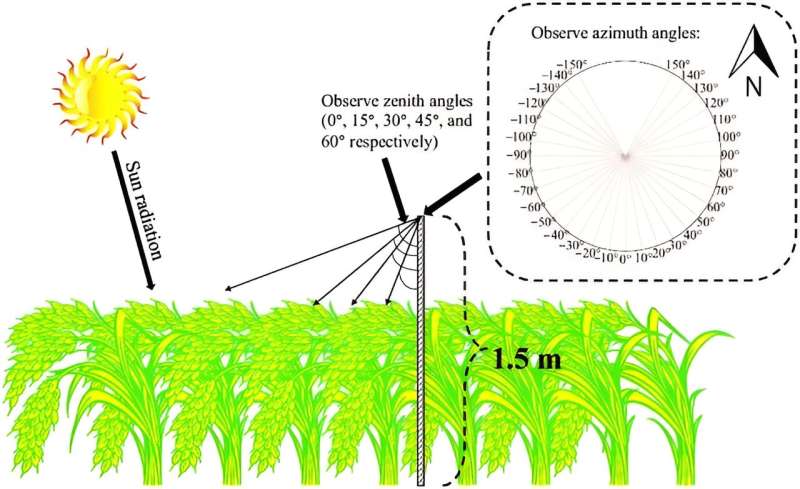This article has been reviewed according to Science X's editorial process and policies. Editors have highlighted the following attributes while ensuring the content's credibility:
fact-checked
trusted source
proofread
Enhancing crop productivity analysis: A novel approach using SIF and PRI for accurate GPP estimation in rice canopies

Solar-induced chlorophyll fluorescence (SIF) and the photochemical reflectance index (PRI) have emerged as significant tools in assessing the photosynthetic and carbon sequestration capacities of terrestrial vegetation, particularly for estimating gross primary productivity (GPP).
However, the relationship between SIF, PRI, and GPP encounters challenges due to large temporal and spatial variabilities as well as the influence of various observational factors such as canopy structure and physiological state.
Despite the potential of multi-angle observations and the Bidirectional Reflectance Distribution Function (BRDF) model to mitigate these issues by accounting for canopy anisotropy and separating physiological signals from environmental influences, the application of these approaches to SIF and PRI for GPP estimation remains underexplored.
Plant Phenomics published research article titled "Establishing a Gross Primary Productivity Model by SIF and PRI on the Rice Canopy."
In this study, researchers employed a multi-angle spectrometer alongside an eddy covariance (EC) system to enhance the precision of GPP estimation within a subtropical rice field in China through the utilization of a PRI-boosting SIF-GPP model. They innovatively applied a semi-empirical kernel-driven BRDF model combined with a two-leaf model for an in-depth analysis of both hotspot and total canopy PRI and SIF (PRIhs/SIFhs and PRItot/SIFtot, respectively).
This dual-model approach facilitated the construction of hotspot and total canopy PRI+SIF-GPP models, whose efficacy was rigorously tested against a validation dataset. The research findings revealed significant correlations between the PRI/SIF indexes and GPP across various timescales, establishing robust linear models for GPP estimation.
Notably, the study uncovered the dynamic responses of PRI/SIF to environmental conditions, quantifying their accuracy through R2, RMSE, and RPD metrics across different models.
The exploration into the temporal dynamics of GPP, LAI, and PAR highlighted the crucial role of clear vs. cloudy weather conditions in determining the strength of these correlations. Particularly, the daily and half-hourly analysis showed that total canopy measures (SIFtot and PRItot) were more effective in mirroring GPP variations than their hotspot counterparts (SIFhs and PRIhs), demonstrating a stronger alignment with GPP's daily and intraday fluctuations.
This alignment was further enhanced by distinguishing between shaded and sunlit leaves within the two-leaf model, which significantly improved the correlation between SIF/PRI and GPP, especially for PRI.
The study also examined the impact of environmental stresses, such as PAR, temperature (T), and vapor pressure deficit (VPD), on PRI and SIF performance, revealing that these factors disproportionately affect the estimation capabilities of PRI and SIF.
Through detailed modeling and validation efforts, the researchers showed that combining PRI and SIF for GPP estimation substantially outperformed individual index models. This superiority was particularly pronounced after integrating the distinction between shaded and sunlit leaves, marking the PRItot+SIFtot-GPP model as the most effective for GPP estimation.
In conclusion, this study not only advances our understanding of the complex interactions between environmental factors, SIF, PRI, and GPP, but also demonstrates the superior estimation capabilities of combined PRI and SIF models, particularly when incorporating nuanced distinctions between canopy components.
This work paves the way for more accurate, non-invasive tracking of crop photosynthesis and carbon sequestration processes, offering valuable insights for future research and practical applications in agriculture and climate change mitigation.
More information: Zhanhao Zhang et al, Establishing a Gross Primary Productivity Model by SIF and PRI on the Rice Canopy, Plant Phenomics (2024). DOI: 10.34133/plantphenomics.0144
Provided by NanJing Agricultural University





















